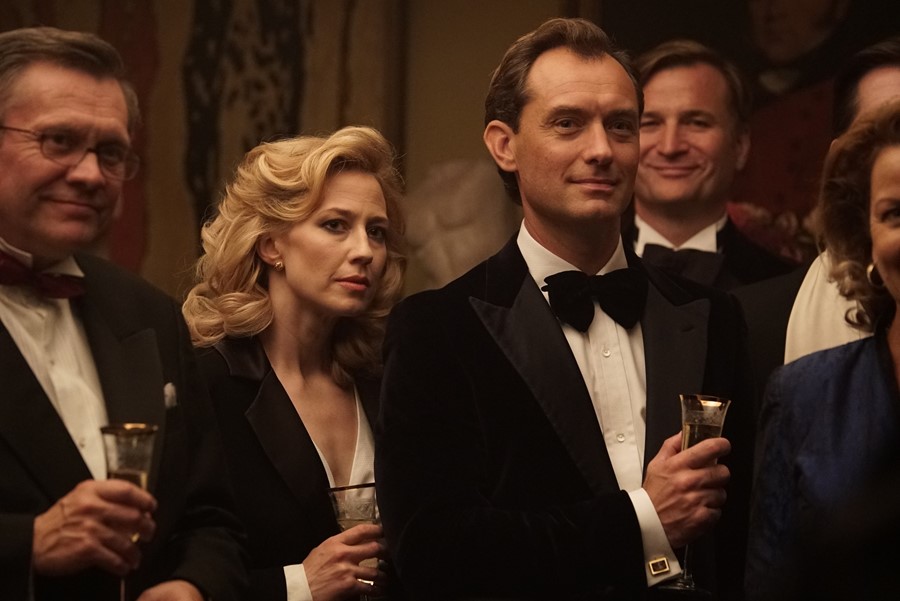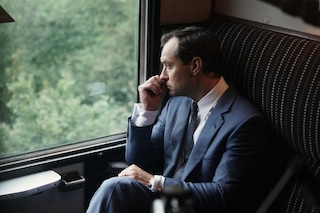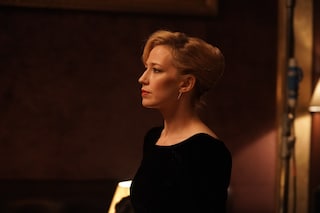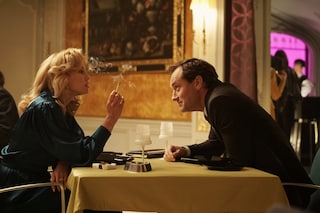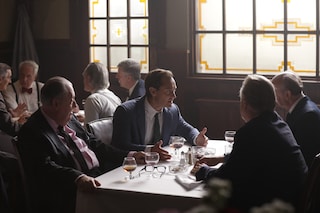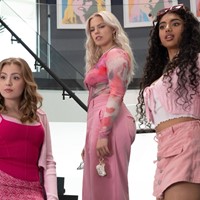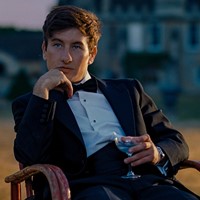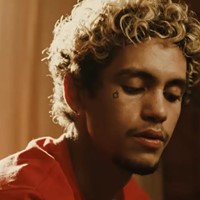The Martha Marcy May Marlene director returns after a decade away with a chilling 80s psychodrama fervent with financial turmoil, starring Jude Law and Carrie Coon
When Sean Durkin was a kid in New York, he stumbled across a horse’s corpse in a field. “A horse had died and been buried,” the director recalls with a grimace. “But they didn’t bury it deep enough. The belly came through, and it was moving because of the gases inside.” The zombie-like image – an equestrian carcass pulsating in the dirt – reappears decades later in the 39-year-old auteur’s dazzling new film, The Nest. “The horse is the biggest metaphor in the movie, but it’s actually a very specific moment from my childhood.”
For Durkin, The Nest is a long-awaited comeback. In 2011, the American writer-director exploded onto the scene with his debut feature, Martha Marcy May Marlene, a paranoid indie that introduced Elizabeth Olsen to the world. Two years later, he followed it up with a miniseries for Channel 4, Southcliffe. However, all his other projects leading up to The Nest fell apart. When Durkin was awarded the Best Director prize at Sundance a decade ago, he presumably didn’t anticipate a nine-year gap until movie number two. “I was just trying hard to get films made that I believed in and loved,” he sighs over Zoom, in mid-August, from New York, where he’s currently shooting a TV show. “That’s where I put my energy.”
Like Martha Marcy May Marlene, The Nest is a horror movie that isn’t exactly a horror movie. In the opening credits, ominous music acts as a warning. The camera spies on a family from a creepy distance. Scenes are paced as if something deeply sinister is about to unfold. Yet Durkin’s dark, foreboding drama isn’t supernatural, nor are there any masked killers. The horror-ish title font makes more sense when Allison (Carrie Coon) and Rory (Jude Law) move into a remote, oversized house in Surrey with their two children, Sam (Oona Roche) and Ben (Charlie Shotwell). The floor creaks. The ceilings are too high. The building is so comically vast and empty, it could be rented for a wedding – or maybe a Blumhouse slasher.
“I’m using genre elements of hauntings to get to the core of the emotional journey,” Durkin explains. “For Allison, it’s a haunted-house story. She’s moving into this place. She’s isolated. Her family is changing around her. She’s discovering things about her husband and her way of life that are based on a lie.” Meanwhile, Ben begs Sam to let him stay in her bedroom as he’s terrified of ghosts. “That was something I felt as a kid. I had a vivid imagination and would run down dark hallways at night, trying to get to bed.”
For the opening stretch of The Nest, the O’Hara family reside in New York where they have friends, a swimming pool, and a reliable income – until Rory, a trader, accepts a job with a former boss in London. Ben is bullied at his new school. Sam deals with Surrey-induced boredom by taking drugs. When Allison accompanies Rory to a work function, she learns that her husband wasn’t offered a role; he instigated the move out of desperation and they’re almost broke. It isn’t immediately obvious but it’s 1986, the year of “the Big Bang”, when Margaret Thatcher deregulated the stock market and chaos ensued. Meanwhile, Allison suffers in silence, knowing that the horse stable she’s constructing near the house is beyond her financial reach.
While Marriage Story was, in my opinion, a near-perfect movie, it was let down by a thinly written kid character who made you wonder if Noah Baumbach was a Benjamin Button figure who’s never been young himself. In contrast, Ben and Sam feel like living, breathing human beings who could, in a different cut, be the protagonists. “Sam’s in her bedroom, taping songs off the radio. They’re deeply personal moments to me as a kid. The most specific you can be with details, the more universal it becomes.”
“You start with reflections on childhood, but then you live through what you’re working on as an adult. It became about family, and ultimately a couple – and how they fight to stay together” – Sean Durkin
According to Durkin, who lived in England until he was 12, there’s a bit of him in all four family members. “It started with my childhood memories,” he says. “But in the years between starting to write the film and finishing it, I got divorced. My production company broke up. I got married. I became a parent. I moved from America to England, and then back to America. You start with reflections on childhood, but then you live through what you’re working on as an adult. It became about family, and ultimately a couple – and how they fight to stay together.”
In Martha Marcy May Marlene, Marcy has just escaped a cult and thus there’s automatic tension built into every scene. However, The Nest one-ups the nerviness through the smart, unsettling placement of the camera. Often, the lens will adopt a voyeuristic angle, as if it’s invading the family’s privacy; then, suddenly, it’ll zoom in so tightly on a face that you’ll squirm in your seat. The cinematographer, Mátyás Erdély, was also responsible for the nightmarish mise-en-scène of Son of Saul.
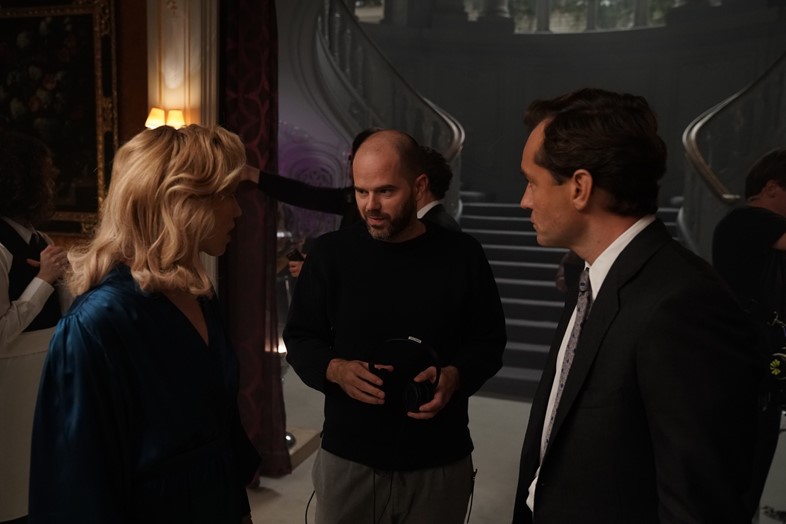
“In the house, we wanted to create space so that Allison could feel isolated,” Durkin says. “There’s other times you get closer to feel the emotion of that isolation. I’m always thinking: what is the best distance? Sometimes it can be more emotional to be distant, and it can be more chilling to be closer. I believe in choosing shots, and not having coverage, and not just putting it together in the edit later. I’m being very specific with every choice that I make, to create the exact feeling that I want in that moment.”
In New York, there are quick camera cuts, whereas in the Surrey mansion, scenes are more likely to comprise a single, lengthy, unbroken take. After a furious fight between Allison and Rory, Durkin lingers on a wooden frame in the background. “When Rory walks out of the room, the camera drifts with him. Then he’s gone, and she’s gone. It’s creating this feeling of the aftermath of an argument, and how they’re both going their own ways.”
Also heightening the genre aspects is the original score by Arcade Fire’s Richard Reed Parry – Durkin describes it as “a jazz score with a haunting element to it”. Perhaps it’s why The Nest was called a “psychological thriller” by Variety and Indiewire at its Sundance premiere last year; its Wikipedia page also classifies it as a “psychological thriller”. Durkin denies ever referring to it with those terms. “Before Sundance, we worked really hard to prepare expectations, and to be like, ‘This is not a thriller.’ But it didn’t work. I don’t know what it is. I guess it’s a thriller in the sense that it’s an emotional thriller.”
“I believe in choosing shots, and not having coverage, and not just putting it together in the edit later. I’m being very specific with every choice that I make, to create the exact feeling that I want in that moment” – Sean Durkin
In terms of inspirations for The Nest, Durkin cites horror fare like Rosemary’s Baby, The Shining, and Don’t Look Now. For the family scenes, he drew from Shoot the Moon and The Ice Storm – the latter is arguably shot by Ang Lee as a haunted-house chiller. “When I was in prep, I was meeting with Carrie and Jude in New York. The Metrograph was showing a 35mm print of The Changeling. I hadn’t seen it in 20 years. It’s kind of hilarious and dated, but it has amazing stuff in it. I realised there were things in it from so long ago that planted seeds in The Nest like the horse-riding scene, and the big, haunted-house feel.”
It helps, too, that Durkin cast two of the most talented actors in the business. Coon, in The Leftovers, already excelled as a depressed mother whose world was falling apart, but as Allison she soars to new heights – partly because her dialogue isn’t written by Damon Lindelof. Similarly, Law’s multifaceted depiction of Rory recalls the character-within-a-character of The Talented Mr Ripley; Rory is not only a compulsive liar to his family, but he seems to be deceiving himself.
While it’s never directly addressed that Sam is only Rory’s stepdaughter, it’s frequently alluded to in the photograph carried around by Rory (him, Allison and Ben, not Sam) and when Allison yells, “Anything you say to me, you can say in front of my children”. The children, in turn, convey this unspoken tension through their body language. “I talk to Charlie and Oona exactly like how I talk to Jude and Carrie,” Durkin says. “I’m there to create the best environment for whatever each actor does, whether that’s giving them space, or if they want to talk more. It doesn’t matter whether it’s Jude or Oona. All actors are the same.”

After Martha Marcy May Marlene and The Nest, viewers may have an idea of what a “Sean Durkin film” looks like, or at least feels like. However, in between those two projects, Durkin attempted to direct Janis, a biopic of Janis Joplin that would have starred Michelle Williams – he left when his script was rewritten against his will into a more cliched story. “Janis was struggling with duality and demons in a way that would have fit really well with Rory and Martha in a cinematic way.” Durkin also came close to adapting Little House on the Prairie for the big screen. “I was very excited to do a children’s adventure movie. Had it got made, you would have seen why – it was to have a darker look at that.”
Not that there’s going to be a lengthy hiatus until Durkin’s next project. Along with the TV series he’s currently shooting (he can’t discuss it on the record), he’s still hoping to write and direct The Von Erichs, a film about a family of wrestlers – although, knowing Durkin, it’ll end up becoming unclassifiable. After all, it feels like a miracle that The Nest exists in 2021, especially when its patient, hard-to-market plotting defies the kind of film that gets financed nowadays. For instance, the next time you watch a made-for-Netflix movie, notice how the premise is frantically established in the first few minutes to patronisingly hook in an impatient subscriber.
“The whole algorithm of what people watch is making its way into everything,” Durkin says. “It’s quite a frightening prospect. Every movie is hard to get made. Everything. No matter who you are, or what you’re doing, everything is hard to get made. And if you’re trying to make something that doesn’t really fit an algorithm, it’s even harder. The Nest doesn’t fit any.”
The Nest is out in UK cinemas August 27
